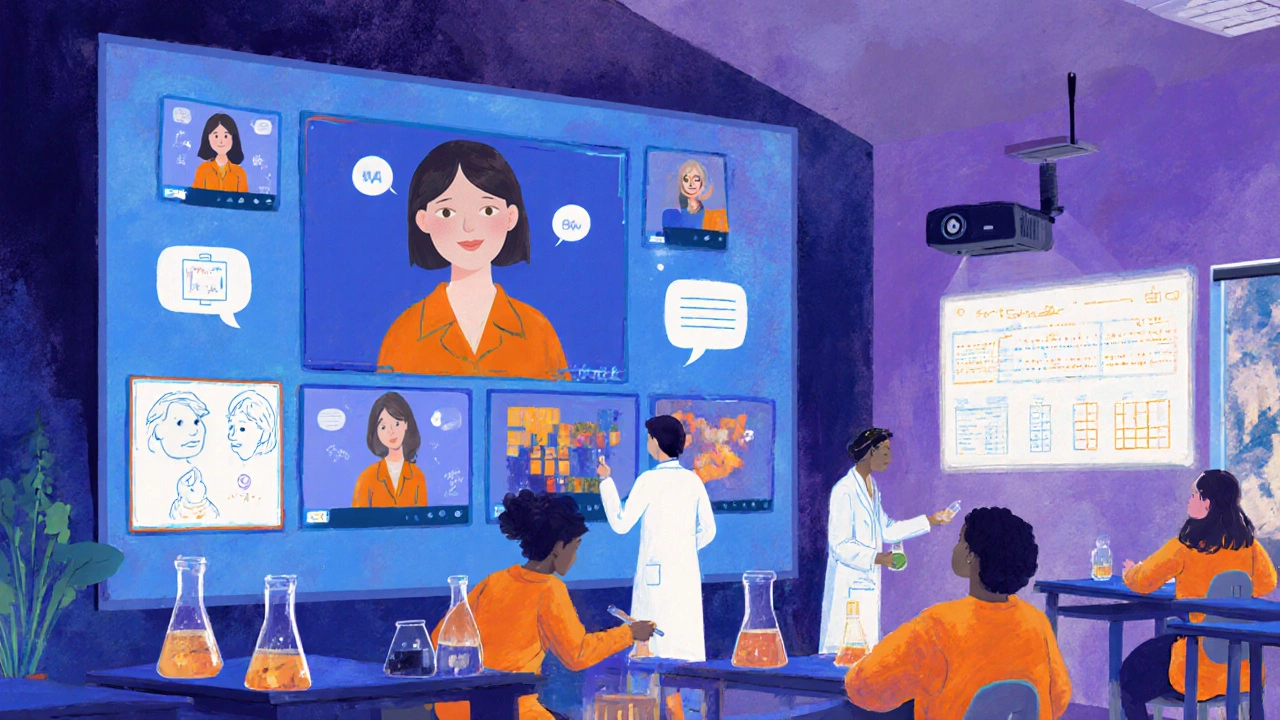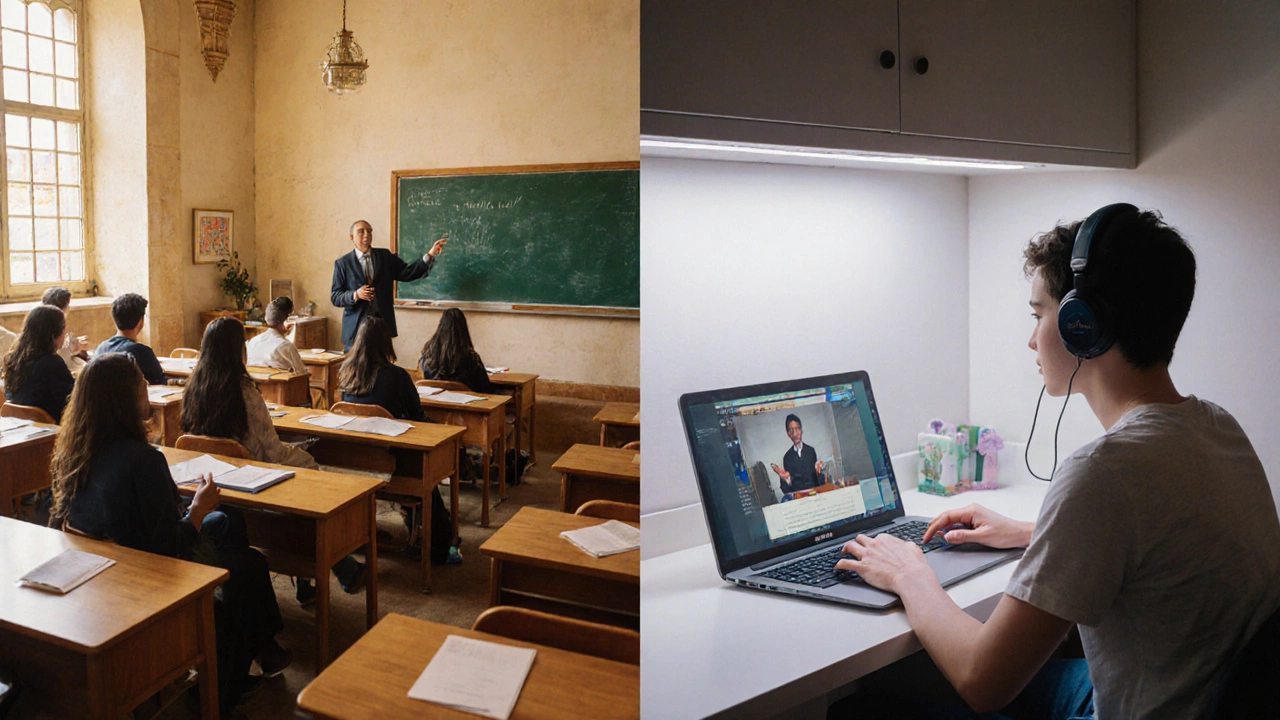Traditional vs Distance Education Comparison Tool
Traditional Education
In-person learning with face-to-face interaction
Distance Education
Online learning with flexible scheduling
Schedule Flexibility
Traditional: Fixed class times and schedules
Distance: Flexible, self-paced options
Interaction Style
Traditional: Face-to-face, spontaneous interactions
Distance: Video, chat, forums - dependent on design
Assessment Methods
Traditional: In-person exams, labs, presentations
Distance: Online proctoring, competency-based assessments
Cost Structure
Traditional: Higher tuition + living expenses
Distance: Lower tuition, tech costs
Decision Guide
Consider these factors:
1. Do you thrive on real-time interaction or prefer self-directed study?
2. Is a fixed schedule important for your routine?
3. Do you have reliable internet and a suitable device?
4. What are the credential requirements for your career goals?
5. How do costs line up with your budget?
Select your preferred learning method to see personalized recommendations
Key Takeaways
- Traditional education relies on physical classrooms, while distance education delivers learning online.
- Interaction in traditional settings is face‑to‑face; distance education mixes synchronous video and asynchronous forums.
- Costs vary: campus fees and commuting for traditional, platform subscriptions and tech needs for distance.
- Both modes can achieve accreditation, but quality assurance processes differ.
- Choosing the right mode depends on learning style, schedule flexibility, and resource availability.
When you hear people talk about "traditional" versus "distance" education, the debate often feels like comparing apples and oranges. Yet both aim to teach the same subjects, assess the same skills, and grant the same credentials. The real distinction lies in where learning happens, how educators deliver content, and what tools students use every day.
Traditional education is a learning model that takes place in a physical location, such as a school, college or university campus, where students and teachers meet face‑to‑face for scheduled lessons. It has been the dominant form of schooling for centuries, built around classrooms, lecture halls and campus facilities.
Distance education refers to courses and programs that are delivered primarily through the internet, allowing learners to study from any location with an internet connection. It emerged with radio lessons in the early 20th century, grew through televised courses, and exploded with modern online platforms.
How each model delivers content
Traditional education leans on a set schedule. Teachers present material in real time, often using blackboards, slides, or physical lab equipment. The rhythm is dictated by the class timetable, and students must be present at the same time and place.
Distance education splits delivery into two main types:
- Synchronous sessions - live video lectures, webinars, or real‑time chats that replicate a classroom hour.
- Asynchronous materials - pre‑recorded videos, readings, quizzes, and discussion boards that students can access any time.
This blend gives learners the freedom to pause, rewind, or skip ahead, something impossible in a live lecture.
Interaction and student engagement
In a brick‑and‑mortar setting, interaction happens organically. A quick question after class, a group project in the lab, or an impromptu debate in the cafeteria foster community. Teachers can read body language, spot confusion, and intervene instantly.
Distance education replaces that cue‑reading with digital tools. Learning Management System (LMS) software that organizes course content, tracks progress, and hosts discussion forums, quizzes, and grades becomes the classroom hub. Features like breakout rooms, real‑time polls, and collaborative documents try to simulate face‑to‑face dynamics. However, the level of engagement heavily depends on how actively the instructor designs interactive activities and how disciplined the learner is.
Assessment methods
Both models use similar assessment types - essays, multiple‑choice exams, presentations, and practical projects. The delivery differs, though:
- Traditional settings often feature in‑person exams under supervised conditions.
- Distance programs may use online proctoring tools, timed quizzes, or open‑book assignments submitted through the LMS.
Some distance providers adopt competency‑based assessments, letting learners progress once they demonstrate mastery, a flexibility rarely found in fixed‑schedule campuses.

Cost and accessibility
Traditional education carries visible costs: tuition, campus facilities, printed textbooks, and commuting or housing expenses. Scholarships and student loans can offset these, but the financial barrier remains high for many.
Distance education cuts many of those overheads. Students save on travel, accommodation, and often on textbook fees because digital resources replace print. However, they need reliable internet, a suitable device, and sometimes a subscription to the learning platform. In low‑bandwidth regions, these tech requirements can become the new hurdle.
Technology infrastructure
In a physical classroom, technology serves as a supplement - a projector, a smartboard, or lab equipment.
For distance learning, technology is the backbone. Platforms such as Moodle an open‑source LMS used by many universities for course delivery and assessment, Canvas a cloud‑based LMS known for its intuitive design and integration capabilities, or commercial solutions like Coursera and Udemy provide the entire learning environment. Reliable video streaming, secure data storage, and mobile app access are now non‑negotiable expectations.
Accreditation and quality assurance
Both traditional and distance institutions can be accredited by the same bodies - for example, the UK’s Quality Assurance Agency (QAA) or regional accrediting agencies in the US. The key difference is how they demonstrate compliance.
- Traditional schools undergo campus visits, facility inspections, and faculty credential reviews.
- Distance providers submit detailed course design documents, evidence of learning outcomes, and often undergo virtual audits of their LMS and assessment security.
Students should always verify accreditation status, as it impacts credit transferability and eligibility for financial aid.
Pros and cons at a glance
| Aspect | Traditional Education | Distance Education |
|---|---|---|
| Location | Physical campus | Anywhere with internet |
| Schedule | Fixed class times | Flexible, self‑paced options |
| Interaction | Face‑to‑face, spontaneous | Video, chat, forums - dependent on design |
| Cost | Higher tuition + living expenses | Lower tuition, tech costs |
| Assessment | In‑person exams, labs | Online proctoring, competency‑based |
| Accreditation | Campus‑based audits | Documented online audits |

Choosing the right mode for you
There’s no universal answer. Consider these questions before deciding:
- Do you thrive on real‑time interaction, or can you stay motivated with self‑directed study?
- Is a fixed schedule important for your routine, or do you need the freedom to learn around work or family commitments?
- Do you have reliable internet and a suitable device, or would a campus environment be more supportive?
- What are the credential requirements for your career goals? Verify that the program, whether traditional or online, holds the necessary accreditation.
- How do costs line up with your budget? Factor in hidden expenses like commuting or tech upgrades.
Many learners now blend both worlds: attending a campus for labs while taking theory courses online. Hybrid models aim to capture the best of each approach.
Practical tips for success in either setting
- Set a dedicated workspace. Whether you’re in a dorm or a home office, a consistent environment signals to your brain that it’s learning time.
- Plan weekly goals. Break larger assignments into bite‑size tasks and schedule them on a calendar.
- Engage actively. In a physical class, ask questions; in an online forum, post reflections and respond to peers.
- Leverage tech tools. Use note‑taking apps, flashcard generators, or screen‑recording software to review material at your own pace.
- Seek feedback. Request regular check‑ins from instructors, whether during office hours on campus or via virtual meetings.
Future trends shaping both models
Hybrid learning, powered by improved video quality and AI‑driven personalization, is blurring the line between traditional and distance education. Adaptive learning platforms analyze student data to serve customized content, while virtual reality labs let remote learners perform experiments as if they were in a physical lab.
Governments are also updating policies. In the UK, the Office for Students now recognises online‑only degrees as equivalent to campus‑based ones, provided they meet the same quality benchmarks. This shift encourages more institutions to invest in robust digital infrastructure.
Bottom line
The core goal of both traditional and distance education remains the same: help learners acquire knowledge and skills. The differences lie in delivery, flexibility, cost, and technology reliance. By understanding these factors, you can pick the path that aligns with your lifestyle, learning preferences, and career ambitions.
Frequently Asked Questions
Is a degree earned online as respected as one earned on campus?
Yes, as long as the program is accredited by a recognised authority. Employers focus on the credential’s legitimacy, not where the coursework was completed.
Can I switch from traditional to distance education halfway through a program?
Many institutions offer credit transfer options. Check with your registrar about eligibility, required documentation, and possible tuition adjustments.
What are the biggest challenges of distance learning?
Isolation, self‑discipline, and technical glitches top the list. Counter them by setting a routine, joining virtual study groups, and ensuring reliable internet access.
Do I need special software to participate in online courses?
Typically a web browser, a word processor, and a video conferencing tool. Some courses require specific applications, which are usually listed in the syllabus.
How do assessment standards compare between the two modes?
Accredited programs meet the same learning outcome criteria, regardless of delivery. The format (in‑person exam vs. online proctored test) may differ, but the rigor is comparable.










